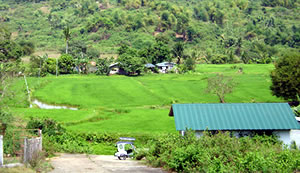
How food arrives at the supermarket or the local restaurant is largely a mystery to most consumers. It is taken for granted that upon arrival at the supermarket, everything on your list will be on a shelf somewhere in the 20 or so aisled store. But the constant supply of beef, chicken, pork, and farm raised fish to market has a direct effect on our planet and our health. The amount of resources necessary for just one hamburger (6 gallons of water) is simply staggering. Here is a little information to help you ponder your diet, your health, and the health of the planet.
The process by which food stock is converted to animal protein is massively inefficient. A detailed 1978 study sponsored by the Departments of Interior and Commerce produced startling figures showing that the value of raw materials consumed to produce food from livestock is greater than the value of all oil, gas, and coal consumed in this country. Expressed another way, one-third of the value of all raw materials consumed for all purposes in the United States is consumed in livestock foods. How can this be?
In the United States, hogs are now fed about as much grain as is fed to cattle. All told, each grain-consuming animal "unit" (as the Department of Agriculture calls our livestock) eats almost two and a half tons of grain, soy, and other feeds each year. For every 16 pounds of grain and soy fed to beef cattle in the United States we only get one pound back in meat on our plates. The other 15 pounds are inaccessible to us, either used by the animal to produce energy or to make some part of its own body that we do not eat, like hair or bones, or excreted. To give you some perspective, 16 pounds of grain has twenty-one times more calories and eight times more protein-but only three times more fat-than a pound of hamburger.
Livestock other than cattle are markedly more efficient in converting grain to meat, hogs consume six, turkeys four, and chickens three pounds of grain and soy to produce one pound of meat. Milk production is even more efficient, with less than one pound of grain fed for every pint of milk produced. (This is partly because we don't have to grow a new cow every time we milk one.)
Putting these two factors together we find that the large quantities of humanly edible plants fed to animals and their inefficient conversion into meat for us to eat is unsustainable. If dairy cows are excluded, the average ratio of all U.S. livestock is seven pounds of grain and soy fed to produce one pound of edible food. Thus, of the 145 million tons of grain and soy fed to our beef cattle, poultry, and hogs in 1979, only 21 million tons were returned to us in meat, poultry and eggs. The rest, about 124 million tons of grain and soybeans, became inaccessible to human consumption. (We also feed considerable quantities of wheat germ, milk products, and fish-meal to livestock, but here I am including only grain and soybeans.) To put this enormous quantity in some perspective, consider that 120 million tons is worth over $20 billion. If cooked, it is the equivalent of one cup of grain for every single human being on earth every day for a year.
This is all without a single mention of the water situation in the world, with the definition of situation in this sense evolving to mean crisis, as Fred Powledge says, who has just written the first in depth book on our national water crisis, "We are in a crisis over our water that is every bit as important and deep as our energy crisis. According to food geographer Georg Borgstrom, to produce a 1-pound steak requires 2,500 gallons of water! The average U.S. diet requires 4,200 gallons of water a day for each person, and of this he estimates animal products account for over 80 percent.
"The water that goes into a 1,000-pound steer would float a destroyer," Newsweek recently reported. Sitting down with a calculator, one may realize that the water used to produce just 10 pounds of steak equals the household consumption of a single family for an entire year.
Irrigation to grow food for livestock, including hay, corn, sorghum, and pasture, uses 50 out of every 100 gallons of water "consumed" in the United States. (Some of this production is exported, but not the major share, since close to half of the irrigated land used for livestock is for pasture and hay.) Other farm uses-daily irrigation for food crops-add another 35 gallons, so agriculture's total use of water equals 85 out of every 100 gallons consumed. This no-price, no-plan policy leads to the rapid depletion of our resources, bringing the day closer when alternatives must be found-but at the same time postponing any search for alternatives. Unless the government realizes that current agricultural policy is wildly inefficient, and more importantly unsustainable, we will move closer and closer to a day when resources become disturbingly limited.
The statistics compiled in this article were derived from the book Diet for a Small Planet by Frances Moore Lappé. You can read excerpts from this book here.
GREENandSAVE.com is a free resource for anyone that wants to save energy, money, and the environment. The articles, product reviews, online tools, and return on investment calculations are researched from a diverse range of public and private sector sources. Overall, the company is passionate about saving money as well as creating healthy homes, offices, and lifestyles.
For information on how to eat more sustainably, and live more efficiently, take a look at GREENandSAVE's tips on a Green Lifestyle. Or, if you are interested in some Home Remodeling Tips, you can find those there as well.

